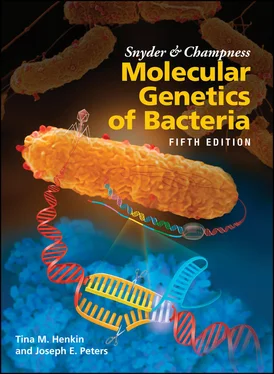Studies with puromycin have contributed greatly to our understanding of translation. The model of the A and P sites in the ribosome and the concept that the 50S ribosome contains the enzyme for peptidyl bond formation came from studies with the antibiotic. Puromycin is not a very useful antibiotic for treating bacterial diseases, however, because it also inhibits translation in eukaryotes, making it toxic in humans and animals. It is, however, one of the few antibiotics that is useful in archaeal genetics, with the availability of resistance cassettes.
Inhibitors that Bind to the 23S rRNA
Chloramphenicol
Chloramphenicol inhibits translation by binding to ribosomes and preventing the binding of aa-tRNA to the A site. It might also inhibit the peptidyltransferase reaction, preventing the formation of peptide bonds. Structural studies have shown that chloramphenicol binds to specific nucleotides in the 23S rRNA, although ribosomal proteins are also part of the binding site.
Chloramphenicol is effective at low concentrations and therefore has been one of the most useful antibiotics for studying cellular functions. For example, it has been used to determine the time in the cell cycle when proteins required for cell division and for initiation of chromosomal replication are synthesized. It is also quite useful in treating bacterial diseases, since it is not very toxic for humans and animals because it is fairly specific for the translation apparatus of bacteria. It can cross the blood-brain barrier, making it useful for treating diseases of the central nervous system, such as bacterial meningitis. Chloramphenicol is bacteriostatic, which means that it stops the growth of bacteria without actually killing them. Such antibiotics should not be used in combination with antibiotics such as penicillin that depend on cell growth for their killing activity, since they neutralize the effect of these other antibiotics.
It takes multiple mutations in ribosomal proteins to make bacteria resistant to chloramphenicol, so resistant mutants are very rare. Some bacteria have enzymes that inactivate chloramphenicol. The genes for these enzymes are often carried on plasmids and transposons, interchangeable DNA elements that are discussed in chapters 4and 8. The best-characterized chloramphenicol resistance gene is the cat gene of transposon Tn 9 , whose product is an enzyme that specifically acetylates (adds an acetyl group to) chloramphenicol, thereby inactivating it. The cat gene has been used extensively as a reporter gene to study gene expression in both bacteria and eukaryotes and has been introduced into many plasmid cloning vectors.
Macrolides
Erythromycin is a member of a large group of antibiotics called the macrolide antibiotics, which have large ring structures. These antibiotics may also inhibit translation by binding to the 23S rRNA and blocking the exit channel of the growing polypeptide. This causes the polypeptide to be released prematurely at either the peptidyltransferase reaction or the translocation step, causing the peptidyl-tRNA to dissociate from the ribosome.
Erythromycin and other macrolide antibiotics have been among the most useful antibiotics. They are effective mostly against Firmicutes but are also useful in treating some other bacterial diseases, including infections by Legionella and Rickettsia . Resistance to macrolide antibiotics occurs in a number of ways. One way is methylation of a specific adenine base in the 23S rRNA, which prevents binding of the antibiotic, by enzymes called the Erm methylases. Some mutational changes in the 23S rRNA can also confer resistance to these antibiotics. Resistance can also occur by acquisition of genes that encode efflux pumps that remove the antibiotic from the cell. New derivatives of the antibiotics must be made constantly to stay ahead of the advancing bacterial resistance.
Thiostrepton
Thiostrepton and other thiopeptide antibiotics block translation by binding to 23S rRNA in the region of the ribosome involved in the peptidyltransferase reaction and preventing the binding of EF-G. Thiostrepton is specific to Firmicutes because it does not cross the outer membrane of Gram-negative bacterial cells.
Most thiostrepton-resistant mutants are missing the L11 ribosomal protein from the 50S ribosomal subunit. This protein seems not to be required for protein synthesis but plays a role in guanosine tetraphosphate synthesis (see chapter 12). Other mutations confer resistance by changing nucleotides in the 23S rRNA close to where the antibiotic binds. Genes de rived from plasmids and transposons can confer resistance by directing specific methylation of 23S rRNA. Eukaryotes may be insensitive to the antibiotic because the analogous ribose sugars of the eukaryotic 28S rRNAs are normally extensively methylated.
Inhibitors of Binding of aa-tRNA to the A Site
Tetracycline was one of the first antibiotics identified. It may inhibit translation by allowing the aa-tRNA–EF-Tu complex to bind to the A site of the ribosome and allowing the GTP on EF-Tu to be cleaved to GDP, but then inhibiting the next step, causing a futile cycle of binding and release of the aa-tRNA from the A site.
Tetracycline has been a very useful antibiotic for treating bacterial diseases, although it is somewhat toxic to humans because it also inhibits the eukaryotic translation apparatus. Unfortunately, overuse has led to the spread of resistance, and it is no longer useful against many infections. In some types of bacteria, ribosomal mutations confer low levels of resistance to tetracycline by changing protein S10 of the ribosome. However, most clinically important resistance to tetracycline and its derivatives is acquired on plasmids and transposons. One of these genes, tetM , carried by Tn 916 and its relatives (see chapter 5), encodes an enzyme that confers resistance by methylating certain bases in the 16S rRNA. Other tetracycline resistance genes, such as the tet genes carried by transposon Tn 10 and plasmid pSC101 of E. coli , confer resistance by pumping tetracycline out of the cell. One of the more interesting types of resistance to tetracyclines is due to the so-called ribosome protection proteins, represented by TetO and TetQ, which bind to the A site of the ribosome and release tetracycline from its binding site. This is the type of resistance exhibited by the soil bacteria that make tetracycline.
Inhibitors of Translocation
Aminoglycosides
Kanamycin and its close relatives neomycin and gentamicin are members of a larger group of antibiotics, the aminoglycoside antibiotics, which also includes streptomycin. They seem to affect translocation by binding to the A site of the ribosome. Aminoglycosides have a very broad spectrum of action, and some of them inhibit translation in plant and animal cells, as well as in bacteria. However, their toxicity, especially during sustained use, and high rates of resistance somewhat limit their usefulness as therapeutic agents.
Bacterial mutants resistant to aminoglycosides arise primarily due to genes exchanged on transposons and plasmids. The products of some of these genes inactivate the aminoglycosides by phosphorylating, acetylating, or adenylating (adding adenosine to) them. For example, the neo gene for kanamycin and neomycin resistance, from transposon Tn 5 , phosphorylates these antibiotics.
Fusidic Acid
Fusidic acid specifically inhibits EF-G (called EF-2 in eukaryotes), probably by preventing its dissociation from the ribosome after GTP cleavage. It has been very useful in studies of the function of ribosomes. In E. coli , mutations that confer resistance to fusidic acid are in the fusA gene, which encodes EF-G. Unexpectedly, some acetyltransferases that confer resistance to chloramphenicol also bind to and inactivate fusidic acid.
Читать дальше











